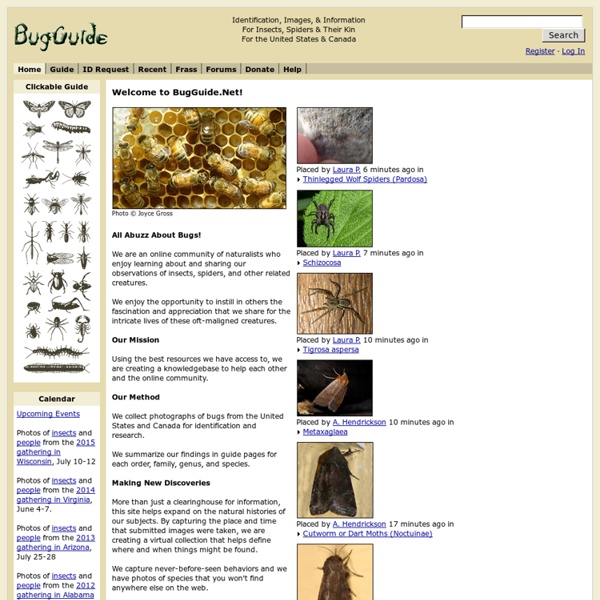



Singing Insects of North America How to use SINASome features of SINACopyrights (ours and others)Contributing to SINARecent contributions to SINAOther acknowledgementsReferencesAbout Singing Insects of North America How to use SINA. Important: Portions of Singing Insects of North America [SINA] will take about two more years to complete. To determine if an insect is a cricket, katydid, or cicada Go to this page ("Home") and click on How to recognize crickets, katydids, and cicadas. To identify an unknown cricket, katydid, or cicada Go to the division dealing with Crickets, Katydids, or Cicadas and click on the Keys button. To learn about a species of cricket, katydid, or cicada for which you know the name Go to the division dealing with Crickets, Katydids, or Cicadas and click on the List of Species button. To learn about a genus or subfamily for which you know the name Go to the appropriate division (Crickets, Katydids, or Cicadas) and click on the List of Species button. To go to a key to the genera of a subfamily you know
Interactive Listing of American/Caribbean Butterflies FINDING A SINGLE TAXON: If you know the scientific or common name the easiest way to find it is to: - Hold down the CONTROL KEY (on PC's) or the COMMAND KEY (on Mac's), select "F", then type the name in the window that appears. This will take you to the first instance the name appears on the Master List. If there are several choices use the arrows next to the search box to scroll through them. SEARCH ENGINE: Typing a name into the SEARCH BOX at the top of each webpage allows you to search the entire website for data; It reads all of the CAPTIONS beneath the images, the REFERENCE LIBRARY and GLOSSARY and lists all the instances where the name occurs. OPENING A MAIN SPECIES PAGE: Once you've found a taxon you wish to view select the highlighted COMMON NAME or DISTRIBUTION NOTES which will open the MAIN SPECIES PAGE. - FAMILY THUMBNAILS: Selecting the blue highlighted name within a FAMILY, SUBFAMILY or TRIBE name will display all the thumbnail images for that group.
PopupTest - test your popup blocker software and download softwa Butterfly Conservation - Sussex Branch MYRMECOS - Insect Photography - Insect Pictures What's That Bug? Southern Bee Killer Robber Fly - Mallophora orcina , captured in Brushy Creek, Round Rock, Texas Badge creator Use Flickriver Badge Creator to create a badge linking to your photos, your group or any other Flickriver view. You can place your badge on your Flickr profile, Blog or Website. Add to your iGoogle or Netvibes page Flickriver widget for iGoogle or Netvibes can display almost any Flickriver view - most interesting today, by user, by group, by tag etc. Clickr on one of the buttons below to install: Embed on your Web site To embed this view, Copy and Paste the following HTML code: Black background ( preview ) : White background ( preview ) : Firefox and Chrome addons Adds a 'Flickriver' button to your browser. Install in Firefox Install in Chrome Search plugin Add 'Search on Flickriver' to your browser's search box. "View on Flickriver" Greasemonkey script A Greasemonkey script that adds Flickriver links to various Flickr photo pages - user photos, favorites, pools etc, allowing to quickly open the corresponding Flickriver view. Install "View on Flickriver" script Bookmarklet
Primate Info Net robber flies - Asilidae common name: robber flies scientific name: Asilidae (Insecta: Diptera: Asilidae) Introduction - Distribution - Description - Biology - Behavior - Key to the Subfamilies of Florida Asilidae - Selected References Introduction (Back to Top) The robber flies are an abundant and diverse family (Asilidae) known for their predatory behavior. Asilidae diversity can be attributed to their broad distribution, as most species tend to occupy a selective niche. Figure 1. Figure 2. Distribution (Back to Top) The Asilidae enjoy a worldwide distribution, with some groups limited to certain regions (Hull 1962). Figure 3. Figure 4. Description (Back to Top) Asilidae are a family of true flies belonging to the superfamily Asiloidea within the suborder Brachycera. All robber flies have a characteristic divot on top of the head, which is located between their especially prominent compound eyes. Figure 5. Figure 6. Biology (Back to Top) Figure 7. Figure 8. Behavior (Back to Top) Figure 9. Figure 10. 1. 2. 3.
Belize  -  Travel Photos by Galen R Frysinger, Belize Belize - Order FREE Brochure! the country Photos from 1990 Belize City Colonial style restoration Other Photos from Belize City Fish Market Waterfront Orange Walk Town More Photos of Orange Walk Town Photos of the Countryside Mask Temple, Lamanai More Photos of Lamanai (2011) Xunantunich Maya site Photos of other Mayan sites in Belize Abandoned Sugar Mill local transport Ambergris Caye Other Photos from Ambergris Caye Recommended Guide Books Return to People and Places Photos of other Central American countries Costa Rica El Salvador Guatemala Honduras Nicaragua Panama Return to People and Places